 Hartlepool Sports & Leisure
Hartlepool Sports & Leisure
- Cinemas, Theatres & Dance Halls
- Musicians & Bands
- At the Seaside
- Parks & Gardens
- Caravans & Camping
- Sport
 Hartlepool Transport
Hartlepool Transport
- Airfields & Aircraft
- Railways
- Buses & Commercial Vehicles
- Cars & Motorbikes
- The Ferry
- Horse drawn vehicles
 A Potted History Of Hartlepool
A Potted History Of Hartlepool
- Unidentified images
- Sources of information
- Archaeology & Ancient History
- Local Government
- Printed Notices & Papers
- Aerial Photographs
- Events, Visitors & VIPs
 Hartlepool Trade & Industry
Hartlepool Trade & Industry
- Trade Fairs
- Local businesses
- Iron & Steel
- Shops & Shopping
- Fishing industry
- Farming & Rural Landscape
- Pubs, Clubs & Hotels
 Hartlepool Health & Education
Hartlepool Health & Education
- Schools & Colleges
- Hospitals & Workhouses
- Public Health & Utilities
- Ambulance Service
- Police Services
- Fire Services
 Hartlepool People
Hartlepool People
 Hartlepool Places
Hartlepool Places
 Hartlepool at War
Hartlepool at War
 Hartlepool Ships & Shipping
Hartlepool Ships & Shipping

Hood, Henry
Henry Chilton Hood 1834-1913
Coxswain of Seaton Carew Lifeboats 1867-1898
(compiled by Maureen Anderson)
William Hood was born in Seaton Carew in about 1791 and had a large family including sons Robert b.1823, William b. c1826, Henry b.1834 and Charles b.c1836. William had become coxswain of the first Seaton lifeboat Tees when it was donated by Thomas Backhouse in 1823. During William’s time as coxswain on this first lifeboat he and his crew saved upwards of 188 lives. In January of 1851 he was presented with a bible and prayer book, a silver tobacco tin and money which had been collected by subscription from the people of Seaton Carew in approval of his conduct as Commander of the lifeboat. In October of 1851 he was awarded a Silver Medal by the Royal Society for the Preservation of Life from Shipwreck for going out to 32 wrecks and saving 120 lives. He died on 6 June 1855 aged 65. His eldest son Robert's position as coxswain of the lifeboat was confirmed on 1 October 1855 and held that position until 1867. In 1857 the Seaton lifeboat was taken over by the R.N.L.I. with a new boat Charlotte donated to Seaton. In 1863 Robert Hood was awarded the Silver Medal for his long and gallant service. The first Charlotte gave service until 1867 when another Charlotte replaced her. Then in 1873 came Job Hindley followed in 1888 by John Lawson and in 1908 Francis Whitbourn. The station was closed in 1922.
In 1851 Henry was aged 17 and a mariner’s apprentice. In 1857 he was married to Mary Allison Brownbridge and by 1861 they were living at 5 Pilot Street, Stranton, West Hartlepool. His occupation was listed as a Hartlepool pilot. In August of 1867 Robert Hood wished to retire as coxswain and an application was put forward to the Hartlepool Pilotage Board for Henry Hood to leave Hartlepool and move to Seaton Carew to become coxswain of their lifeboat. To do this he had to first obtain an ‘In and Out Branch’ as Pilot for the Tees which licence would have to be granted by Trinity House. This was duly granted in September 1867. By 1871 the family was living in Ashburn Street, Seaton Carew. In 1890 they were living at 15 Commercial Street, Middleton in the Parish of Stranton and in1891 they were living at Corner’s Garden and by 1901 Front Street.
Because of some mix-up with tug boats, on 11 March 1883 instead of running into Hartlepool Bay, the Norwegian schooner Atlas with her crew of five men went aground on the Longscar Rocks which jut out to sea from Seaton Carew. The signals of distress were seen and no time was lost in getting horses and men to equip the lifeboat. It was 9.45pm and dark when eight horses and 15 men managed to launch and push the life boat out to sea. Keeping to the lee of the rocks as much as possible the 13 crew of the lifeboat searched for the stricken schooner but could not see her because of the terrible sea running and sleet and hail forming a thick, freezing veil.
The lifeboat could not be taken nearer the rocks as she would haven smashed like a matchstick so a decision was taken by John Franklin and Henry Hood to do a search of the reef on foot as it was low tide. They groped their way along until on the north-east point nearest Hartlepool they saw the vessel with the seas breaking completely over her. They retraced their steps to the lifeboat and called for a heaving line which was thrown to them. At this point Matthew Franklin joined them in the water. Reaching a point near the ship they threw the heaving line which was caught by the captain but it also struck him below the knee. The mate had jumped overboard and he and the captain were barely conscious. Eventually step by step, hand over hand all five were taken aboard the lifeboat with Henry being dragged in last with severe leg cramps. They were back on shore by 12.30am and soon after the schooner had completely broken up.
John and Matthew Franklin and Henry Hood were all awarded Silver Medals for their bravery during this rescue. Henry also had the Albert Medal of the second class conferred upon him by Queen Victoria.
Henry eventually retired in August 1898 after 31 years as coxswain. He and his crew had been instrumental in saving 89 lives. On his retirement he was awarded the Silver Second Service Clasp Medal, a framed Certificate of Service from the R.N.L.I. and from the crew of the lifeboat and friends of Seaton Carew a silver watch, gold chain and £30.
In about 2010 the medals and silver watch were passed to the Hartlepool Museum by members of the Crawford family who had found them in their loft. It transpired that they were descendants of Henry and his family but had not known anything of the family history. Henry had left the items in his will to his niece Elizabeth Crawford, the daughter of his brother, John.
Related items :
 Henry Hood
Henry Hood
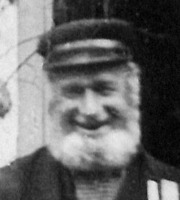 Donated by Maureen Anderson
Donated by Maureen AndersonHenry Hood, Coxswain of Seaton Carew Lifeboats is interred in Holy Trinity Churchyard. His wife, Elizabeth (nee Brownridge) is interred with him.
More detail » Henry Hood and wife Mary
Henry Hood and wife Mary
 Donated by Maureen Anderson
Donated by Maureen AndersonHenry Hood, coxswain, with his wife Mary (nee Brownbridge born 1833 died 1909) outside their cottage at Southend. They were married in 1857.
More detail » Henry Hood coxswain (1)
Henry Hood coxswain (1)
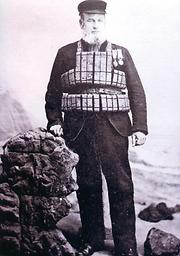 Donated by Douglas Ferriday
Donated by Douglas FerridayPart of the Hartlepool Library Service collection
Henry Chilton Hood followed his father, William, and his brother, Robert, by becoming coxswain of the Seaton Carew lifeboats in August 1867. He remained in this role for thirty-one years until his retirement in 1898. He died in 1913 aged 80.
More detail » Henry Hood coxswain (2)
Henry Hood coxswain (2)
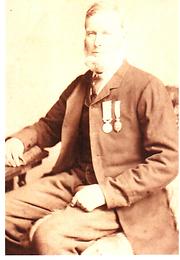 Donated by Maureen Anderson
Donated by Maureen AndersonHenry wearing his medals. In March 1883 he and his crew went to the assistance of the schooner Atlas when she ran aground on Longscar Rocks. Henry and John and Matthew Franklin were awarded the RNLI Silver medal for their bravery. Queen Victoria also conferred the Albert Medal second class on Henry for his part in the rescue. On his retirement he was voted a second silver clasp to his Silver Medal.
More detail » Henry Hood headstone (1)
Henry Hood headstone (1)
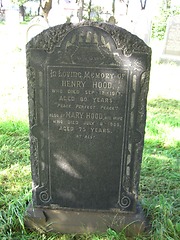 Created by Maureen Anderson
Donated by Maureen Anderson
Created by Maureen Anderson
Donated by Maureen AndersonThe headstone for Henry Hood and his wife, Mary, in Holy Trinity Churchyard. Note within the M.I. there is no mention of the bravery he showed during his lifetime.
More detail » Henry Hood headstone (2)
Henry Hood headstone (2)
 Created by Maureen Anderson
Donated by Maureen Anderson
Created by Maureen Anderson
Donated by Maureen AndersonDated 2007
M.I. in Holy Trinity Churchyard reads: In Loving Memory of Henry Hood died 12 September 1913 aged 80 years. Peace Perfect Peace. Also of Mary Hood his wife died 8 July 1909 aged 75 years. At Rest.
More detail » Henry Hood lifesaving medal
Henry Hood lifesaving medal
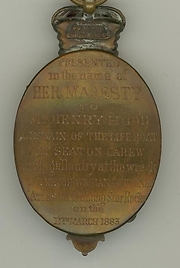 Donated by Maureen Anderson
Donated by Maureen AndersonIn about 2010 the medals awarded to Henry Hood for assisting in the rescue of the crew of the Atlas wrecked on Longscar Rocks at Seaton Carew in March 1883 were found in a descendant's loft. They were donated to Hartlepool Museums and are now exhibited in the Maritime Museum. This is the Albert Medal awarded by Queen Victoria in 1883 for his part in the rescue of the crew of the schooner Atlas.
More detail » Is the Wreck on Seaton Carew Beach the Brig Granite?
Is the Wreck on Seaton Carew Beach the Brig Granite?
Seaton Carew Wreck by Maureen Anderson
In 1996 the wreck of a wooden ship was exposed on the northern part of Seaton Carew beach allowing archaeologists to carry out a fairly detailed survey. It appeared again between 2002 & 2004 allowing further investigation. In 2005 it was partially exposed for most of the time & was not seen at all in 2006 & 2007. From about April 2013 it has been visible throughout the year, possibly because of work being carried out on new sea defenses & promenade which is changing the geography of the beach. The wreck is intertidal so is at the mercy of the waves which means that exposure can vary almost daily. The strong wind often experienced on this part of the coast also has an effect as sand fills & empties from the area in & around the vessel. Sadly, because it is so exposed it has become vulnerable to the elements & the only means of preservation would for it to become buried under the sand again.
Although it was stated by locals that 1996 was the first time the wreck had been seen in over 50 years an earlier photo seems to belie this. Taken by John Yeadon from the North Gare breakwater in the summer of 1983 the photo captures the remains of the Doris. Wrecked in 1930 she was stripped on the beach & her remains are embedded in the sand further north & a little higher up the beach than the Seaton wreck, also intertidal. The photographer, when taking his image of the Doris, has caught the outline shape of the other wreck further along the beach showing that it must have been very near to the surface of the sand in that year (see image 1 below).
The archaeological investigations recorded by Tees Archaeology on the Seaton wreck found that the surviving hull included 91 starboard & 71 port frames. Although the frames stood to 1.5m above the sand, they had been uniformly cut. The planks, frames & ceiling were in good condition & the keelson had steps for two masts indicating that she was a brig (see image 2 below).
The exposed remains were measured at 25.1m (82 feet 4 inches) long x 7.07m (23 feet 2 inches) broad at the widest point. The vessel had been carvel-built & fastened with treenails. Timbers sampled largely proved to be of oak, although a sprung plank at the bow was elm & there was also a larch ceiling plank. The hull appears to have had wooden sheathing. Four iron ‘eyes’, each apparently a one-piece casting or mounted on an iron plate, were attached, low down, to the inner hull planking. The plate measured 21cm. long & the lug of the eye 12cm. long. There was also evidence of a small number of square-section iron nails having been used to fasten some of the ceiling planks to the frames. There was damage to the port side near the stern which could have been due to a collision, damage by storms or have been done deliberately to salvage her cargo. It was thought that at least seven feet of the hull remains buried beneath the sand. Dendrochronology tests were carried out to try & determine the age of the wood but were unsuccessful.
The Granite 1846-1888
Walter Hood & Co, Aberdeen: completed 9 January 1846; yard no. 187; official no. 693; code letters HDVF.
Specifications at time of build; two masts; carvel built oak, larch & elm wood & part iron brig; 256g; 180nt; 101.3/6 x 21.3/12 x 13.3/6 (feet); (approx. 30m x 6.49m x 4m); standing bowsprit; female figurehead.
Owners: 1846 Aberdeen Commercial Lime Company (Blackie’s Quay) & others, Aberdeen; 1885 Thomas Jefferson, Scarborough Street, West Hartlepool (still registered Aberdeen).
Masters: 1846 Alexander Sinclair; 1847-53 John McPherson; 1853-72 Peter Cadenhead; May 1872 –February 1874 Duncan; April 1874-February 1875 Sutherland; April 1875-April & September 1880 Patrick; January-December 1880 Henderson; January 1881-December 1884 Benzie; 1885-1888 Richard Leng.
Many of her early voyages were from Aberdeen to London & Archangel.
Miscellaneous: 10 September 1853 the body of John MacPherson, master of the Granite, was found about 50 yards from where the vessel was lying at Archangel. It was assumed he must have accidentally fallen into the water when going ashore or returning.
26 September 1886 she was in collision with the steamer Edward Eccles which caused the Granite to lose her jibboom, bowsprit & figurehead.
The Last Voyage of the Granite:
On the morning of Tuesday, 13 November 1888 the wind was blowing strongly from the south-east with a heavy sea. Bound from London for Middlesbrough with a cargo of loam (a high nutrient form of soil mainly used in agriculture) & a crew of eight, the Granite was trying to enter the Tees when she was carried to leeward. The tug Dauntless got hold of her rope just as the Granite grounded six or seven hundred yards from the breakwater but the master of the tug had to slip the rope for fear of damage to his own vessel. The tug Agamemnon of Middlesbrough was on the river when the mate, Phillip Newton, saw the Granite ashore. Her masts were holding but working from side to side with the sea & she was beginning to break up. At that time all the crew were on the rail against the fore-rigging (see image 3 below).
On her first rescue mission the Seaton Carew lifeboat, John Lawson, was pulling through the broken sea so the tug took her in tow. Once the lifeboat was as close as it could get to the Granite grappling irons were thrown but they fell short & slipped down the outside of the brig’s bulwarks. At about 11am the masts fell & at the same time three men jumped overboard as the brig began to break up. Two were washed away to the north but one man was picked up by the tug about half an hour later. This proved to be the master, Richard Leng, & although every effort was made to revive him, it was too late. The lifeboat circled the area looking for any signs of life amongst the wreckage & saw one man but as they approached he was swirled away from them & disappeared. After four hours of searching they had to admit defeat & returned to shore (see image 4 below).
Meanwhile the Middlesbrough lifeboat had also made its way to assist in the rescue but by the time it was manned & towed to the scene it was around noon & too late. The coxswain, John Thirlwell, stated at the later inquiry that they did not know of the events taking place until about 10.30 but if they had known sooner their lifeboat could have perhaps got to the scene in less time than the Seaton lifeboat. At that time it was not the practice to telegraph from Seaton to Middlesbrough in the event of a vessel in distress being sighted.
Henry Hood, coxswain & Robert Robinson, second coxswain of the Seaton lifeboat, in giving their evidence at the inquiry said the boat was pulled by eight horses for about a mile over the sands. She then had to be launched on the north side of the breakwater because there was no road over the slag bank. The sand on the north side was like quicksand which made it extremely difficult to maneuver. If there had been a road it would have taken them well over an hour less to reach the Granite. Also if they could have dropped the lifeboat on the other side of the breakwater where there was smooth water it would have made a substantial difference as they could have reached the Granite with ease & perhaps managed to save the crew. Both the distance & the tide coming in were factors to make it an extremely difficult operation. He suggested that a lifeboat should be stationed at the Fifth Buoy Light inside Seaton Snook or inside the South Gare breakwater (see image 5 below).
Apparently a road across the breakwater was begun about a year previously but the work was discontinued. The Coroner at the inquest stated that at the time of this tragedy great works were being carried out at Teesmouth which perhaps could not be done without temporarily endangering something.
Seaton lifeboat crew: Henry Hood, coxswain; Robert Robinson 2nd coxswain; William & Robert Hood; Thomas Blenkinsop; J Kendall; Fred Kitson; William Proctor; Matthew Franklin; William Harrison & Richard Burton.
The Service Return, completed by Henry Hood, stated that ‘She (the lifeboat) took such sea as they never before experienced.’
To add to the terrible tragedy of that day one of the large crowd of onlookers, 69 year old Mary Anne Strover, collapsed & died on the beach. The doctor that attended her said she had suffered heart disease after having been overcome by the ‘excitement’ (see image 6 below).
16 November 1888 the body of William Harland was found by John Henry Franklin in a hole in the sand in the Inner Deep at the North Gare. Because there was no road it took several men to carry the body across the breakwater & then for a distance of half a mile before it could be placed on a cart & taken to the Seaton Hotel.
2 December 1888 the body of William Pearson Storm was found on the sands in front of the old town of Hartlepool.
7 December 1888 a body was found immediately below the road wall at Middleton. It was several hours before the body was removed as a misunderstanding arose as to which police jurisdiction the spot where it was found came under! Although known to be from the Granite the body was unidentifiable.
12 December 1888 the body of John Richard Steel was found on the south side of the North Gare breakwater near Seaton.
12 December 1888 the body of David Buckley was found floating near Hartlepool pier head by two fishermen. David had entered the Hartlepool Workhouse in May of 1883 along with two of his siblings after having been abandoned half-starved & poorly clothed by their parents near the iron railway arch at Throston. David had been apprenticed to the Granite about five months prior to her being wrecked.
16 December 1888 a body was found floating near the Teesmouth. Although known to be from the Granite this body was also unidentifiable.
23 December 1888 the body of Welburn Atkinson was found on Seaton Sands.
Lives lost November 1888:
Atkinson, Welburn, seaman, Scarborough
Buckley, David, 17, apprentice, born Birkenhead, inmate of Hartlepool Workhouse
Harland, William, 19, able seaman, 92 Scarborough Street, West Hartlepool (buried 18 November 1888 Hartlepool Cemetery)
Leng, Richard, master, 44, born Robin Hood’s Bay, resided 57 Alliance Street, Hartlepool
Palmer, James Dixon, apprentice, Whitby
Perkins, Henry, able seaman, Whitby
Steel, John Richard, mate, 23, born Robin Hood’s Bay (nephew of Richard Leng)
Storm, William Pearson, apprentice, 17, born Robin Hood’s Bay
Comparisons
Both vessels had two masts, were carvel built & consisted of oak, elm & larch woods.
The measurements taken of the Seaton wreck were of the remaining hull so, although a guideline, they are not of the complete vessel which would have certainly been longer & perhaps a little wider when intact. She drove inshore prow first so this part of the vessel is the most deeply buried in the sand. Taking all this into account the width of the two vessels would have been remarkably similar.
Granite when built: 101.3/6 x 21.3/12 feet & inches (approx. 30m x 6.49m) Height was 13.3/6 feet (approx. 4m).
Seaton Wreck: 25.1m (approx. 82 feet) long x 7.07m (approx. 23 feet) broad at the widest point. There was evidence of a few iron nails & a small iron plate in the Seaton wreck & iron, which could refer to nails, is recorded in the building of the Granite. There may have been more iron in the Seaton wreck which is buried under the sand or has long since rusted away.
James Pattison, curate of Holy Trinity Church in Seaton Carew from 1885 to 1890, took up the hobby of photography in late 1887 with most of his photos of Seaton taken between 1888 & 1889 & a few in 1890. Although many of his glass plates & photos were dated, two that are of a wreck on Seaton beach were not, but they are of the same wreck we see today as can be seen by a comparison between one of his photos & one taken in 2013. The early photos show that the stern post & a substantial part of the frames are still intact so this was before salvage of the usable wood. Normally salvage of every piece of wood that could be removed would be carried out as soon as possible as it was such a valuable commodity. This seems to prove that the early photos were taken almost straight after the hull drove ashore.
One example of the speed in which salvage was carried out is recorded on a poster which advertised items to be auctioned at Seaton on 26 January 1835 from the wrecks of the brigs Fanny & Mitchell. They were both wrecked on 17 December 1834 so were salvaged & sold within less than a month.
The records state that her masts fell & the Granite broke up when she was driven onto the rocks near the North Gare off the mouth of the Tees. If the Seaton wreck is the Granite the damage to the port side near the stern may have occurred when she grounded or when she came off the rocks. This would also account for the battered state of the wreck in the early photo.
The bodies of the drowned sailors were found between 16 November & 23 December in six different locations. In 1898 four bodies from the wreck of the Birger at Redcar all washed up on Seaton beach. These facts show, with the unpredictable currents around the Teesmouth, debris can be washed up at various locations. It is, therefore, quite possible that what was left of the Granite could have driven ashore on Seaton beach.
As a friend pointed out ‘absence of evidence is not evidence of absence’ but having trawled through newspapers & wreck reports from 1887 to 1890 I could find no other stranding or wreck of any vessel between Hartlepool & Teesmouth for that period which could be linked to Pattison’s photos.
More detail » Lifeboat Crews
Lifeboat Crews
Images and stories relating to the Hartlepool and Seaton Carew lifeboat crews.
More detail » Lifeboats
Lifeboats
Images and material relating to the Lifeboats and their crews, stationed at Hartlepool, West Hartlepool and Seaton Carew since the early 1800s.
More detail » Shipping and Seafarers
Shipping and Seafarers
Notable seafaring people in Hartlepool, including ship owners, brokers, chandlers and sailors.
More detail »



